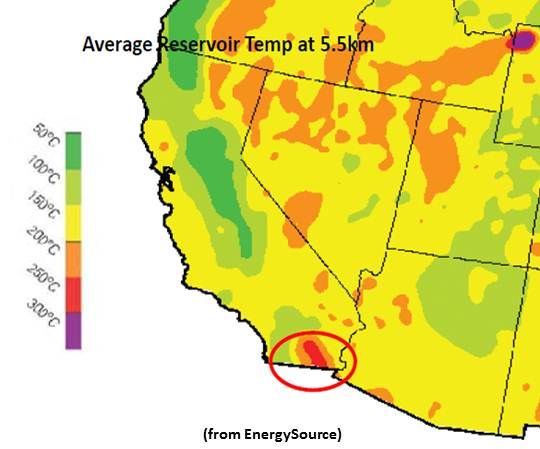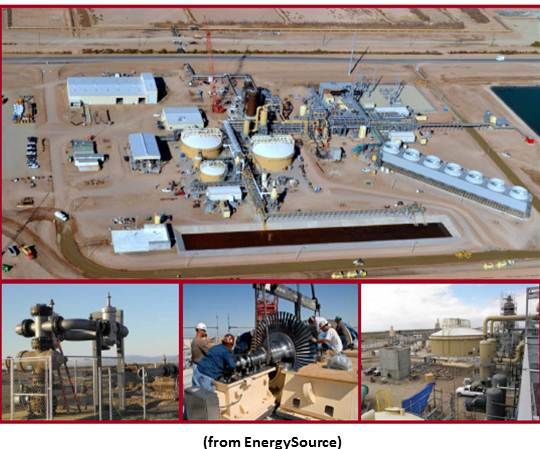The Salton Sea known geothermal resource area (KGRA), EnergySource President and CEO Dave Watson said, has a total economically recoverable geothermal resource potential of between 1,400 and 2,000 megawatts. It has a developed capacity of just under 330 megawatts.
Among geothermal opportunities, Watson said, “the Salton Sea KGRA is unique. It is the most powerful resource in the U.S.,” with “a capacity factor approaching 95 percent. It has the best combination of high pressure, very high temperatures -- 600 degrees Fahrenheit and above -- and very good permeability, because you’re drilling into a sedimentary basin.”
The area’s last standalone geothermal plant was completed in 1991 by the predecessors of CalEnergy, which now owns and operates all the area’s output except EnergySource’s new plant.
Initial development in the Salton Sea KGRA region ended in the early 1990s, just as the pioneering utility-scale solar and wind projects were brought to a halt by the termination of early California investment incentives and a steep fall in natural gas prices.
But in the post-September 11 era, federal and state incentives and a California renewable energy standard (RES) have revived development in all the utility-scale renewables sectors. EnergySource’s interest came out of that expansion.
“The unique thing about geothermal,” Watson noted, “is that it is baseload, and there are few real renewable baseload resources.”

Watson said EnergySource acquired the lease in January 2006 and spent two years obtaining basic development financing. The exploration drilling, which began in 2008, proved a well with the right pressure, temperature and mass flow at a well site on the almost 1,500-acre Hudson Ranch lease.
EnergySource worked with Hannon Armstrong Capital to form an eight-bank group that provided the plant’s $400 million construction financing. A 30-year power purchase agreement (PPA) for the plant’s entire 49.9-megawatt output was arranged with Arizona municipal utility Salt River Project (SRP).
The three production wells at Hudson Ranch I go to a depth of 7,500 feet, Watson explained. Steam is triple-flashed from the liquid brought up to drive a turbine and a hot, briny liquid from deep in the earth is passed through the plant. “We’re returning 80 percent of the liquid or more,” Watson said.
Only one feature of the Salton Sea resource qualifies its value. “There are a lot of minerals” in the hot, briny solution “that can clog up your whole system.”
Clearing those minerals means extra infrastructure and operational expense, Watson said. “We have a chemical plant next to our geothermal plant.” The chemical plant “treats the brine” so that what is returned to the injection wells "is polished brine or clean brine, which has much less capability to corrode or scale your injection wells.”
The extra expense is financeable, Watson said, because “your resource is very secure in the Salton Sea.”

Simbol Materials, which specializes in the recovery of usable minerals like zinc, manganese and lithium from geothermal brine, will be part of the next Hudson Ranch project, Watson said. Simbol will divert the briny liquid, filter out the sand-like silica and salts, and return the liquid into EnergySource’s four well reinjection system. EnergySource, Watson said, does not expect to see a revenue stream from the minerals recovery.
Since the Hudson Ranch I plant went on-line March 9, the most unexpected thing that has happened, Watson said, “is that we have had very few problems.”
EnergySource contracted with Performance Mechanical, a local operations and maintenance company, for the construction. They employed an average of 200 people for the twenty-one-month building period, with 250 people employed during the peak construction months. The plant has a permanent operations staff of 34.
Watson said economists estimate the plant could provide benefits to the Imperial Valley region of three times the EnergySource investment in the form of payroll taxes, property taxes and local business activity.
EnergySource already has a PPA with SRP for a 49.9-megawatt Hudson Ranch II on the Salton Sea lease. Exploration drilling will begin later this year. The company is gradually putting in place a pipeline of 49- to 100-megawatt projects they plan to begin bringing on-line in the 2016 to 2020 period -- just in time for the 33 percent renewables deadline of the California RES,
With the RES driving renewables development, Watson said, “We’re competing with solar right now.”
The solar industry’s investment tax credit (ITC) runs through 2016. Wind is temporarily out of the race because it has all but lost its federal production tax credit (PTC), which expires at the end of 2012. Geothermal’s PTC runs to the end of 2013, and the industry has, Watson said, a “statutory 10 percent ITC” to fall back on.
“Solar has huge advantages over other technologies,” Watson said. But “at some point they’re going to want some grid stability.” He added, “We’re running twenty-four hours a day. When the utilities get tired of dealing with intermittency and want baseload renewable, there’s really only one source and that’s geothermal. And there’s really only one field that has a lot more capacity and that’s the Salton Sea.”



